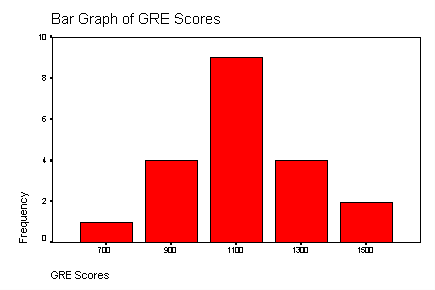Worked Problem Set No. 1
Answer 4
- Use the following set of data on marital status (M = married; S = single) and GRE scores from 20 applicants to a graduate program in educational administrations to work problems a - e
| Status | GRE | Status | GRE | ||
|
S |
1020 | S | 1100 | ||
| S | 1070 | M | 760 | ||
| M | 1350 | S | 880 | ||
| S | 960 | S | 1410 | ||
| S | 1030 | M | 1030 | ||
| M | 1300 | S | 1040 | ||
| M | 1090 | S | 980 | ||
| S | 1030 | M | 1340 | ||
| S | 880 | S | 1180 | ||
| S | 1410 | S | 1340 |
- Construct ungrouped frequency, percentage, cumulative frequency, and cumulative percentage distributions for the GRE scores.
- What are the percentile ranks for GRE scores of 880 and 1300?
- Construct a grouped frequency, percentage, cumulative frequency, and cumulative percentage distributions for the GRE scores.
- Construct a bar graph for GRE scores.
- Construct a histogram, using grouped intervals, for GRE scores.
ANSWERS
Using SPSS, First Convert the string variable 'Status' to a categorical (nominal) variable, e.g., 1's and 2's, and enter the data into SPSS (Note, you could enter the data as is, one column for 'status' and one column for 'gre,' and then use TRANSFORM to compute the coded categorical variable).
Next run:
SPSS: ANALYZE®DESCRIPTIVE STATISTICS® FREQUENCIES.
Enter the GRE score as the variable to be analyzed.
Click on CHARTS ®BAR CHARTS®CONTINUE®OK.
- (and b.) This yields the following table of ungrouped frequencies, percents, and cumulative percents. Only the cumulative frequencies are not given. However, these are easily computed by cumulating frequencies as you move down the table. For instance, the cumulative frequency for score 880 is 3, for 960 it is 4, and so on.

- The grouped frequency distribution has to be computed by hand. You can decide on the number of intervals following the guidelines given in the text.
I chose five intervals: 600.5-799.5, 799.5-999.5, 999.5-1199.5, 1199.5-1399.5, and 1399.5-1599.5, with midpoints at 700, 900, 1100, 1300, and 1500, respectively. From this I obtained the table below.
Grouped Frequency and Percent Distribution
Midpoint Freq. Percent Cum. Freq. Cum. Pct. 700 1 5 1 5 900 4 20 5 25 1100 9 45 14 70 1300 4 20 18 90 1500 2 10 20 100
-
The bar graph can be computed directly from the above table. It should look something like the following.

-
The histogram for the GRE scores looks like the following. You can get this graph with SPSS by again clicking on ANALYZE® DESCRIPTIVE STATISTICS®FREQUENCIES and CHARTS ®HISTOGRAMS. Then click on FORMAT and click on Suppress tables with more than n categories and set the Maximum number of categories at 5.
